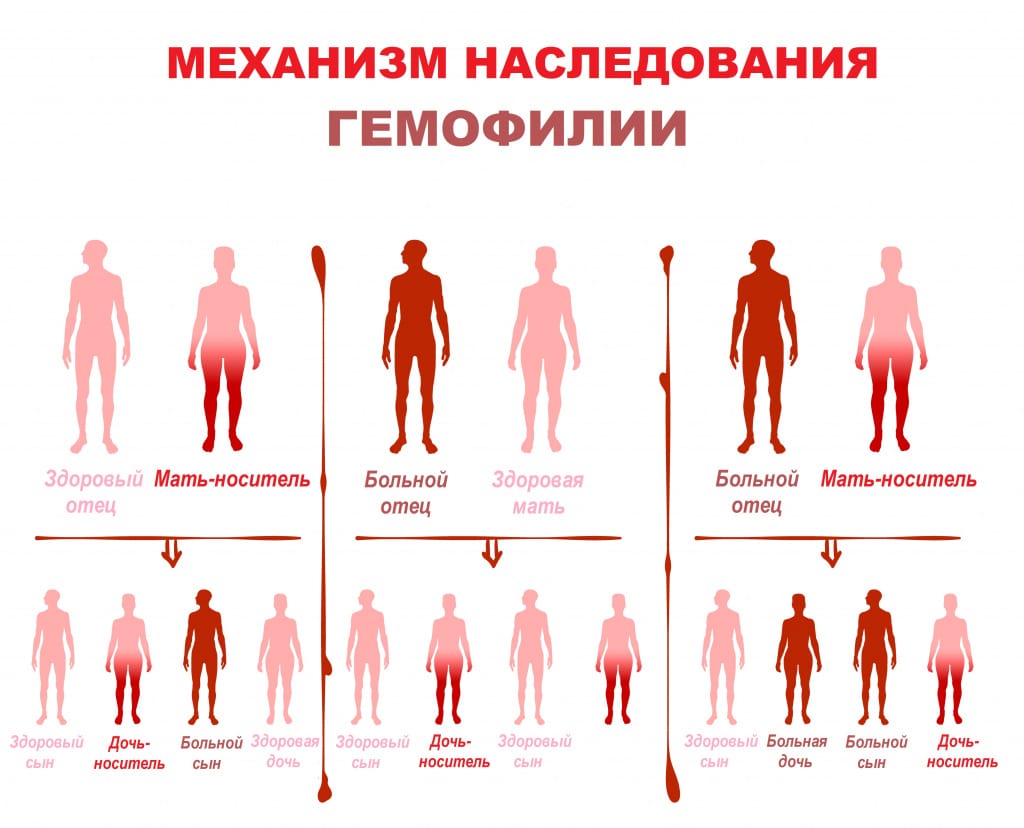It is widely believed that the “royal disease” affects only men, and women can only be its carriers. We decided to check whether this belief is correct.
The fact that hemophilia is an exclusively male disease, write in some medical reference books and on websites healthcare institutions. IN memo The official protocol for the treatment of this disease, prepared by the Ministry of Health of the Russian Federation, also does not mention the spread of hemophilia among women. In many Russian-language publications about this disease in Media And blogs They mention Tsarevich Alexei, who suffered from it, who is believed to have inherited hemophilia from his mother, and she from her grandmother, the British Queen Victoria. However, about the manifestations of hemophilia in women in such texts often nothing is said. Authors of popular science books briefly talk about rare cases of hemophilia in women. articles.
Hemophilia is hereditary violation blood clotting. Depending on which groups of substances (clotting factors) the body lacks, hemophilia A (caused by a deficiency of factor VIII) and hemophilia B (caused by a deficiency of factor IX) are distinguished. Hemophilia is also sometimes called deficiency of blood clotting factor XI, most often found among Ashkenazi Jews, but its mode of inheritance and clinical manifestations differ significantly from the more common types A and B, therefore in modern scientific literature it is not classified as hemophilia. Hemophilia is characterized by increased bleeding from the first days of life - subcutaneous, intermuscular, subfascial, retroperitoneal hematomas, bleeding from the gums and nose, hemorrhages in the internal organs, eyes, joints. They can occur either due to injuries or operations, or without them - due to the vulnerability of the walls of blood vessels. Highlight three degrees of hemophilia: mild (clotting factor VIII or IX level from 5% to 40% of normal), moderate (from 1% to 5% of normal) and severe (less than 1% of normal).
The idea of hemophilia as a disease that manifests itself exclusively in men probably arose precisely because of its prevalence among members of the ruling houses of Europe at the turn of the 19th and 20th centuries. Manifestations of the disease were noticeable in the son of Nicholas II, Tsarevich Alexei, German, Spanish and other princes, but not in their sisters or mothers. The common ancestor of the heirs was the British Queen Victoria.
This phenomenon was later studied by geneticists. It turned out that the production of clotting factors VIII and IX is encoded on the X chromosome. Since men have only one X chromosome (chromosomal set XY), it is enough for them to inherit one damaged X chromosome from their mother so that the clotting factor is not produced in normal quantities, that is, hemophilia manifests itself. A woman’s chromosome set is XX, one chromosome is inherited from the mother, the second from the father, that is, for a woman to develop hemophilia, she must receive one damaged chromosome from both parents. However, until the middle of the last century duration The life expectancy of men suffering from this disease was very low - young men with hemophilia, on average, lived only up to 20 years and the vast majority did not have time to leave offspring.

The situation has changed thanks to the development of replacement therapy methods. Currently, the life expectancy of men with hemophilia is only ten years below average, and therefore the likelihood of having daughters who inherited the disease has increased. In 2023, the world will have hemophilia were sick approximately 400,000 men, female carriers were 1.6 times more, that is, approximately 640,000. If one of these 400,000 men meets one of these 640,000 women, their daughter will definitely receive the damaged X chromosome from the father and with a 50% probability the same from the mother. The likelihood of this event seems low, but in communities that practice consanguineous marriages, it higher.
However, only 70% of hemophilia cases connected with inheritance of mutation from parents. The remaining 30% is the so-called sporadic hemophilia, when a mutation in a gene occurs on its own. Such a change can occur with equal probability in both men and women, and their children may already inherit a damaged copy of the gene. It is likely that Queen Victoria arose namely sporadic hemophilia - at least there is no evidence that her parents had problems with blood clotting. However, such a mutation that occurs in a woman usually makes her not sick, but only a carrier, as was the case with Victoria, and then with those of her daughters who inherited the damaged chromosome.
However, carriers cannot automatically be classified as people without problems with blood clotting. It's all about lyonization X chromosomes - a process named after scientist Mary Lyon. To prevent the two copies of X chromosomes in a female from producing twice as many corresponding genes as in males, one chromosome in each cell is “switched off.” How the choice occurs is not completely clear to scientists - most likely, the organism does it by chance. However, the distribution is almost uniform, that is, in approximately half of the cells of the female body the maternal X chromosome is “turned off”, and in half the paternal X chromosome is “turned off”. If equality is violated “in favor” of mutated chromosomes, the woman develops problems with blood clotting. According to the European Hemophilia Consortium, due to lyonization, on average, female carriers approximately 50% of normal clotting factor level. Moreover, while hemophilia in men on therapy occurs when the clotting factor level falls below 40% of normal, in women, abnormal bleeding may occur when this level is between 40% and 60% (in which case it is usually They say about a symptomatic carrier).
It turns out that a woman can suffer from hemophilia, that is, suffer from clotting factor deficiency, in three cases:
- if she is the daughter of a father with hemophilia and a carrier mother;
- if she inherited a damaged gene from one of her parents, and as a result of lyonization, more healthy X chromosomes are “turned off” in her body;
- if she was born from healthy parents, but a spontaneous mutation occurred in her genome and, as a result of lyonization, more healthy X chromosomes were also “turned off” in her body.
By assessment According to the World Federation of Hemophilia, in 2012, there were approximately 364,000 men with hemophilia type A, 97,000 men with hemophilia type B, and just over 359,000 women worldwide who suffered from abnormal bleeding associated with one of the three pathways described above. That is, there are not much more men with hemophilia than women suffering from it (approximately 56% and 44%, respectively).
Hemophilia in women compared to men complicated a number of additional problems. Firstly, they experience more heavy and prolonged menstruation - menorrhagia, which due to significant blood loss can lead to iron deficiency anemia. Heavy menstruation may push women to a reduction in social activity. In addition, they are susceptible to bleeding during ovulation and in the period before menopause, as well as bleeding into simple ovarian cysts, which requires urgent surgical intervention. In some cases, women with hemophilia even undergo a hysterectomy. Secondly, pregnancy in women with hemophilia coupled with an increased risk of life-threatening bleeding, both during labor and in the following weeks. However, usually women suffer from mild and moderate forms of hemophilia, while severe forms occur predominantly in men.
However, obtaining adequate medical care for women suffering from this disease is difficult. Swiss pharmaceutical company Roche notesthat they are routinely excluded from important clinical trials—monthly fluctuations in hormone levels make it difficult to test drugs in women. Therefore, many innovative treatments are developed exclusively with male volunteers and are approved by regulators only for them.
Thus, it is absolutely wrong to believe that hemophilia is an exclusively male disease, and women can only be its carriers. Firstly, a woman will suffer from hemophilia if she inherits one damaged X chromosome from both her father and mother. Secondly, approximately every third case of hemophilia is obtained as a result of a spontaneous mutation, and not together with the genes of the parents. Thirdly, even with one damaged chromosome, a female carrier may suffer from abnormal bleeding, since due to the lyonization process, approximately half of the healthy X chromosomes will be in a “switched off” state. Research shows that there are slightly fewer women with hemophilia than men.
Cover image: RawPixel
Read on the topic:
If you find a spelling or grammatical error, please let us know by highlighting the error text and clicking Ctrl+Enter.






